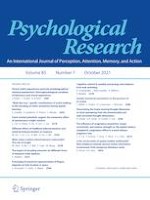We often work together with other human beings to reach shared goals trying to improve the team performance. But frequently, we also compete against other people either alone (e.g., in a single tennis match) or together with other people (e.g., in tennis doubles) trying to achieve group goals at the expense of others’ goals. When working in independent groups as in bowling or golf, task characteristics of the group performance can be seen as additive (Steiner,
1972). However, in co-acting (e.g., in paddling) or interacting groups (e.g., in basketball), task characteristics of the group performance are typically seen as conjunctive (Steiner,
1972). The aim of this study is to test if competitive/cooperative processing modes (i.e., metacontrol states) between partners change the degree of bodily self-other integration in co-acting dyadic groups. Sebanz, Bekkering, and Knoblich (
2006) defined joint action as any form of social interaction, where two or more people coordinate their behavior in space and time to bring about a change in the environment. To coordinate their behavior, two persons need to form a representation of the other person’s action at some level (Liepelt & Prinz,
2011; Vesper, Butterfill, Knoblich, & Sebanz,
2010). Cognitive science investigated if and to what extent people mentally represent their own and other person’s actions (Dittrich, Dolk, Rothe-Wulf, Klauer, & Prinz,
2013; Dittrich, Rothe, & Klauer,
2012; Dolk, Hommel, Prinz, & Liepelt,
2013; Kiernan, Ray, & Welsh,
2012; Liepelt, Wenke, Fischer, & Prinz,
2011; Sebanz, Knoblich, & Prinz,
2003; Wenke, Atmaca, Holländer, Liepelt, Baess, & Prinz
2011) and other person’s tasks (Klempova & Liepelt,
2016; Sebanz, Knoblich, & Prinz,
2005; Yamaguchi, Wall, & Hommel,
2018,
2019), and how this impacts both persons’ behavior. A prominent paradigm of this line of research is the social or joint Simon paradigm (Sebanz, et al.,
2003), in which two people share the standard version of the Simon task (Simon,
1969; Simon, Hinrichs, & Craft,
1970). The classic version of the Simon task is a two-choice task, in which one participant has to decide between two different items of a specific category (e.g., color or form) and to respond by pushing one of two laterally located response keys. This stimulus randomly appears laterally on the left or right side of a computer screen, whereby the stimulus location is task irrelevant. Even though stimulus location is task irrelevant, participants show a stimulus–response (S–R) compatibility effect. This S–R effect typically shows faster reaction times when stimulus and response location correspond (compatible trial), compared to when they do not correspond (incompatible trial). This effect is known as the Simon effect (Simon, et al.,
1970; Simon & Small,
1969; Simon & Wolf,
1963). Sebanz et al. (
2003) transformed the Simon task into an individual go/no go task, so that the individual has to respond to only one of two possible stimuli, while having to withhold the response to the other stimulus. In their study, Sebanz et al. showed that the Simon effect breaks down when performing this go/no go task alone. In addition, a third condition was added, in which the same Simon task was distributed across two persons, each person doing only half of the task, so that both persons now share the two-choice Simon task. As in the go/no go task condition, each person has to respond to only one of the two stimuli and to withhold the response to the other stimulus, whereby now the co-actor takes over the response to the other stimulus. In this joint-task setting, the Simon effect reemerged, but now across both persons sharing the task. This effect was therefore called the social Simon effect (Sebanz et al.,
2003) or joint Simon effect—short the JSE.
